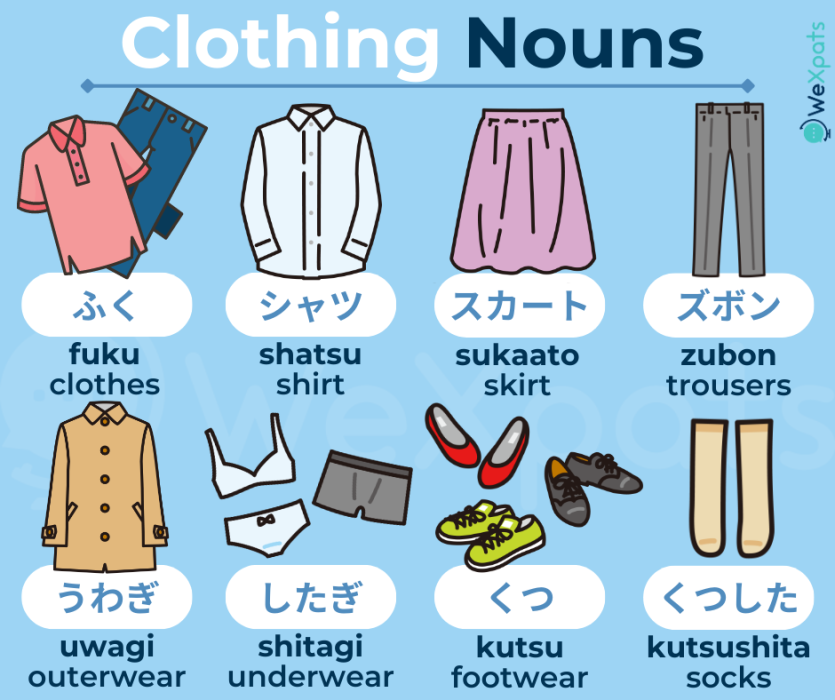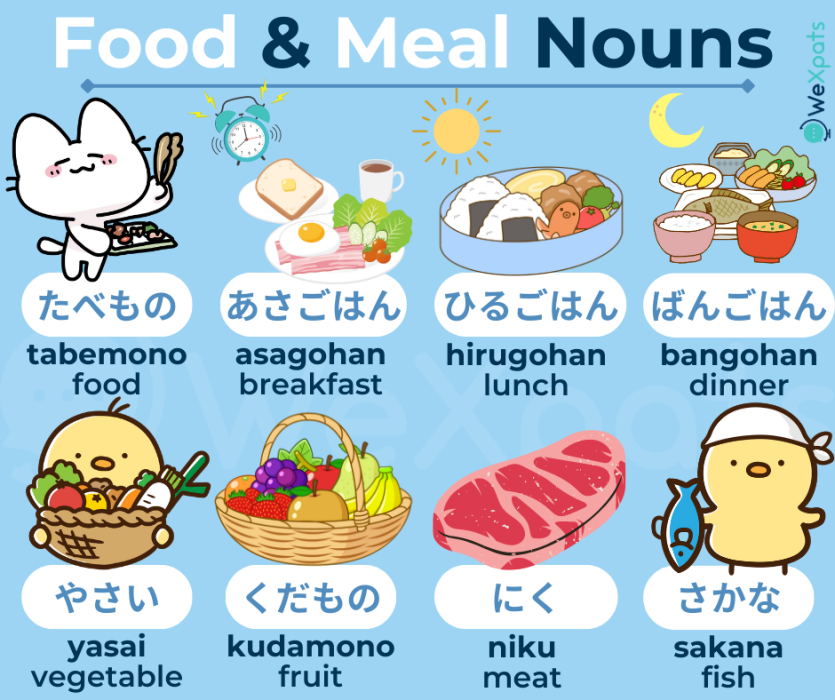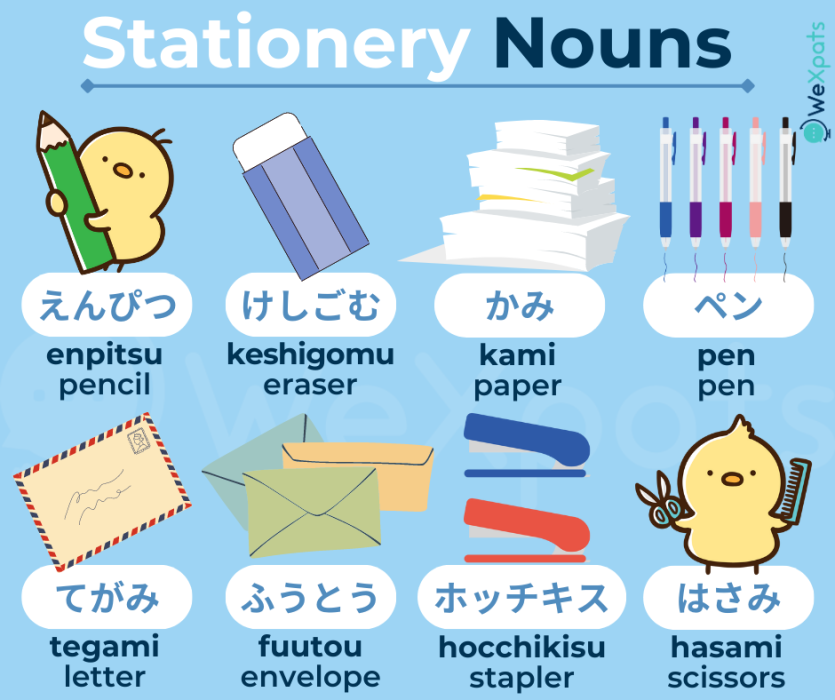The last part of the N5 Nouns List article collection. In this part, we will learn 151 N5 nouns related to the body, clothing, food & drinks, and stationery & studies. By the time you have completed all 5 parts of N5 Nouns Lists, you’d have studied close to 600 Japanese vocabulary words.
Table of Contents
- N5 Nouns List - Body
- N5 Nouns List - Clothing
- N5 Nouns List - Food & Meals
- N5 Nouns List - Stationery & Studies
- Simple Sentences at the N5 Level
In the first half of the article, we will focus on 79 Japanese vocabulary words for the body, clothing, and food & meals category. How are they related?
-
Body : Basic body parts like limbs and head.
-
Clothing : We wear clothes and accessories on our body.
-
Food & Meals : We need to consume meals everyday. Food & drinks go inside our body.
Not just to pass the N5 exams, these are practical words that are useful in everyday life and you may need them when the time comes.
Quick Note : There is barely any Kanji (only 2) that you need to remember for this part. However, there are many Katakana vocabulary so hopefully you have a good grasp on Katakana by now.
N5 Nouns List - Body
Learn what the basic body parts are called in Japanese. Useful for when you need to see a doctor in Japan too for any medical maladies.

|
からだ |
体 |
body |
|
あたま |
頭 |
head |
|
かみ |
髪 |
hair |
|
め |
目 |
eye |
|
みみ |
耳 |
ear |
|
はな |
鼻 |
nose |
|
くち |
口 |
mouth |
|
は |
歯 |
tooth; teeth |
|
こえ |
声 |
voice |
|
くび |
首 |
neck |
|
うで |
腕 |
arm |
|
て |
手 |
hand; arm |
|
ゆび |
指 |
finger |
|
おなか |
お腹 |
stomach |
|
あし |
足 |
foot; leg |
Writer's Pick
N5 Nouns List - Clothing
How to say the different types of clothing and accessories that goes on our backs. You’ll have no problem going shopping in Japan now.

|
うわぎ |
上着 |
outer garment |
|
かばん |
鞄 |
bag |
|
きもの |
着物 |
Japanese traditional clothing; kimono |
|
くつ |
靴 |
shoes |
|
くつした |
靴下 |
socks |
|
さいふ |
財布 |
wallet; purse |
|
したぎ |
下着 |
underwear |
|
せびろ |
背広 |
business suit |
|
てぶくろ |
手袋 |
gloves |
|
ふく |
服 |
clothes |
|
ぼうし |
帽子 |
hat; cap |
|
めがね |
眼鏡 |
spectacles; glasses |
|
ようふく |
洋服 |
Western clothes |
Katakana Vocabulary
Many types of clothing have Katakana names. There are so many that we separated them from the Kanji ones above so it’s easier to remember.
|
Tシャツ |
T-shirt |
|
イヤリング |
earring |
|
サングラス |
sunglasses |
|
サンダル |
sandal |
|
ジャケット |
jacket |
|
シャツ |
shirt |
|
スーツ |
suit (clothing) |
|
スカート |
skirt |
|
ズボン |
trousers; pants |
|
スリッパ |
slippers |
|
セーター |
sweater |
|
ドレス |
dress |
|
ネクタイ |
necktie |
|
ハンカチ |
handkerchief |
|
ベルト |
belt |
|
ポケット |
|
|
ボタン |
button |
|
ワイシャツ |
formal shirt |
N5 Nouns List - Food & Meals
The most important (and fun) part of our day is taking a rest with a nice meal. Learn what the different meals of the day are called, and names of food, drinks, and cutlery.

Meals of the Day
The 3 basic meals of the day. Easy to remember - Japanese for morning / afternoon / night + ごはん (gohan) - meal. In future, you will also learn the other ways to call the meals of the day in Japanese, for example ランチ (ranchi), the Katakana for “lunch”, and 朝食 (choushoku) - breakfast.
|
あさごはん |
朝ご飯 |
breakfast |
|
ひるごはん |
昼ご飯 |
lunch |
|
ばんごはん |
晩ご飯 |
dinner |
|
ゆうはん |
夕飯 |
dinner |
Food
We have separated this subcategory into several parts to make it easier to remember. This first part is the basic Japanese terms for “food” and “meal”, broad categories of food, and basic Japanese condiments used for cooking.
|
たべもの |
食べ物 |
food |
|
りょうり |
料理 |
cuisine; food |
|
ごはん |
ご飯 |
rice; meal |
|
おべんとう |
お弁当 |
lunch box |
|
おかし |
お菓子 |
candy; sweets |
|
しお |
塩 |
salt |
|
さとう |
砂糖 |
sugar |
|
しょうゆ |
醬油 |
soy sauce |
This part is about vegetables and fruits, including the names of some fruit.
|
やさい |
野菜 |
vegetable |
|
くだもの |
果物 |
fruit |
|
バナナ |
- |
banana |
|
いちご |
- |
strawberry |
|
みかん |
蜜柑 |
mandarin orange |
|
りんご |
林檎 |
apple |
|
トマト |
- |
tomato |
Food with names in hiragana and kanji. Remember the kanji for tempura in BOLD.
|
あめ |
飴 |
sweets; candy |
|
うどん |
- |
udon |
|
おにぎり |
- |
rice ball; onigiri |
|
そば |
蕎麦 |
soba |
|
たまご |
卵 |
egg |
|
にく |
肉 |
meat |
|
ぎゅうにく |
牛肉 |
beef |
|
とりにく |
鶏肉 |
chicken meat |
|
ぶたにく |
豚肉 |
pork |
|
みそしる |
味噌汁 |
miso soup |
|
さかな |
魚 |
fish |
|
すきやき |
すき焼き |
sukiyaki |
|
さしみ |
刺身 |
sashimi |
|
すし |
寿司 |
sushi |
|
てんぷら |
天ぷら |
tempura |
Food with Katakana names.
|
アイスクリーム |
ice cream |
|
カレー |
curry |
|
ケーキ |
cake |
|
サンドイッチ |
sandwich |
|
スープ |
soup |
|
スパゲッティ |
spaghetti |
|
チョコレート |
chocolate |
|
バター |
butter |
|
パン |
bread |
|
ハンバーガー |
hamburger |
|
ピザ |
pizza |
Drinks
Some common drinks to know. Remember the kanji for water in BOLD.
|
のみもの |
飲み物 |
drink; beverage |
|
おさけ |
お酒 |
alcohol |
|
おちゃ |
お茶 |
tea (usually green) |
|
ぎゅうにゅう |
牛乳 |
milk |
|
ミルク |
- |
milk |
|
こうちゃ |
紅茶 |
black tea |
|
コーヒー |
- |
coffee |
|
ジュース |
- |
juice |
|
ビール |
- |
beer |
|
みず |
水 |
water |
|
ワイン |
- |
wine |
Cutlery
Names of different cutlery in Japanese. コップ (koppu) and カップ (kappu) can be confusing, they sound very similar but mean differnt things.
|
ちゃわん |
茶碗 |
rice bowl; teacup |
|
おさら |
お皿 |
plate |
|
はし |
箸 |
chopsticks |
|
コップ |
- |
glass (for drinking); tumbler |
|
カップ |
- |
cup |
|
フォーク |
- |
fork |
|
ナイフ |
- |
knife |
|
スプーン |
- |
spoon |
N5 Nouns List - Stationery & Studies
There are 41 Japanese vocabulary words that you need to learn about stationery & studies.

Stationery
Names of stationery that you will most likely need to use while learning Japanese or studying abroad in Japan. Stationery is called 筆記用具 (hikki-yougu) in Japanese, which you will learn at a higher JJLPT level.
|
えんぴつ |
鉛筆 |
pencil |
|
カード |
- |
card |
|
かみ |
紙 |
paper |
|
きって |
切手 |
stamp (postage) |
|
けいさんき |
計算機 |
calculator |
|
けしごむ |
消ゴム |
eraser |
|
コピー |
- |
copy; photocopy |
|
シャーペン |
- |
mechanical pencil |
|
セロテープ |
- |
cellophane tape |
|
てがみ |
手紙 |
letter |
|
てちょう |
手帳 |
notebook; pocket diary: memo pad |
|
ノート |
- |
note; notebook |
|
はがき |
葉書 |
postcard |
|
はさみ |
鋏 |
scissors |
|
ふうとう |
封筒 |
envelope |
|
ふでばこ |
筆箱 |
pencil case; pencil box |
|
ペン |
- |
pen |
|
ボールペン |
- |
ballpen |
|
ホッチキス |
- |
stapler |
|
まんねんひつ |
万年筆 |
fountain pen |
|
めいし |
名刺 |
namecard |
Studies
Since you are studying the Japanese language, naturally you will need to learn some Japanese vobulary related to studies.
|
ローマじ |
ローマ字 |
romaji |
|
かたかな |
片仮名 |
katakana |
|
ひらがな |
平仮名 |
hiragana |
|
かんじ |
漢字 |
kanji |
|
いみ |
意味 |
meaning |
|
クラス |
- |
class |
|
こたえ |
答え |
answer |
|
さくぶん |
作文 |
writing; composition |
|
じ |
字 |
character; writing |
|
しけん |
試験 |
examination; test |
|
じしょ |
辞書 |
dictionary |
|
しつもん |
質問 |
question; inquiry |
|
じゅぎょう |
授業 |
class; lesson |
|
しゅくだい |
宿題 |
homework; assignment |
|
テスト |
- |
test; examination |
|
ぶんしょう |
文章 |
written passage; sentence |
|
もんだい |
問題 |
question (on a test); problem |
|
ページ |
- |
page |
|
レポート |
- |
report |
|
れんしゅう |
練習 |
practice |
Simple Sentences at the N5 Level
Here are example sentences that utilize the N5 nouns learnt above, as indicated in BOLD. Try making your own sentences.
1. 先生、昨日からおなかがいたいです。
(sensei, kinou kara onaka ga itai desu)
- Doctor, my stomach has been hurting since yesterday.
2. あのあおいシャツをきている男の子はだれですか?
(ano aoi shattsu o kiteiru otoko no ko wa dare desuka?)
- Who is that boy wearing a blue shirt?
3. 今日はさむいのでうわぎをきます。
(kyou wa samui no de uwagi o kimasu)
- It is cold today so I am wearing a coat.
4. あさごはんはいつもパンを食べます。
(asagohan wa itsumo pan wo tabemasu)
- I always eat bread for breakfast.
5. わたしはコーヒーをのむのがすきです。
(watashi wa koohii o nomu no ga suki desu)
- I like to drink coffee.
6. けしごむをもっていません。かしてくれますか?
(keshigomu o motteimasen. kashitekuremasuka?)
- I forgot to bring an eraser. Can you lend me one?
7. じゅぎょうをはじめましょう。
(jugyou o hajimemashou)
- Let’s start class.
8. このもんだいのこたえはなんですか?
(kono mondai no kotae wa nandesuka?)
- What is the answer to this question?
Congratulations! Now that you’ve finished ALL 5 PARTS of the JLPT N5 Noun List Articles, you’ve learnt close to 600 Japanese vocabulary! You’ve done well!





































